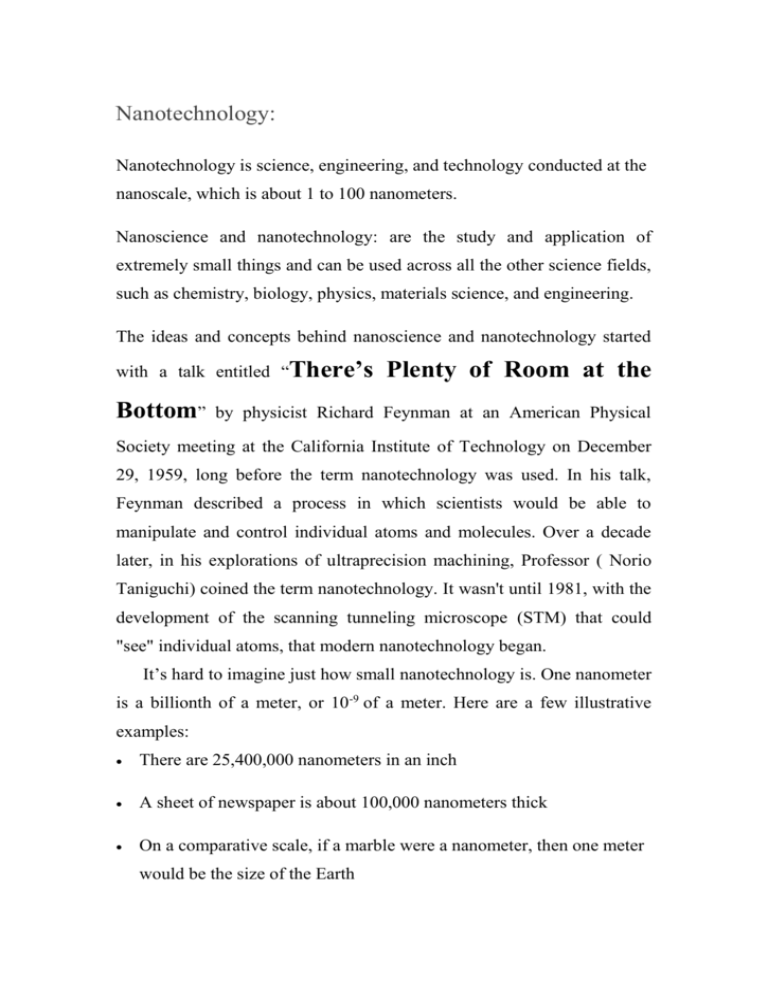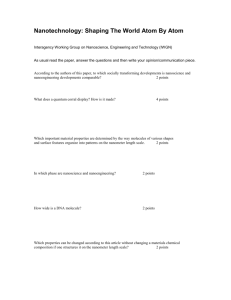Nanotechnology Time The Next Big Step Steam Engines Railways
advertisement

Nanotechnology: Nanotechnology is science, engineering, and technology conducted at the nanoscale, which is about 1 to 100 nanometers. Nanoscience and nanotechnology: are the study and application of extremely small things and can be used across all the other science fields, such as chemistry, biology, physics, materials science, and engineering. The ideas and concepts behind nanoscience and nanotechnology started with a talk entitled “There’s Bottom” Plenty of Room at the by physicist Richard Feynman at an American Physical Society meeting at the California Institute of Technology on December 29, 1959, long before the term nanotechnology was used. In his talk, Feynman described a process in which scientists would be able to manipulate and control individual atoms and molecules. Over a decade later, in his explorations of ultraprecision machining, Professor ( Norio Taniguchi) coined the term nanotechnology. It wasn't until 1981, with the development of the scanning tunneling microscope (STM) that could "see" individual atoms, that modern nanotechnology began. It’s hard to imagine just how small nanotechnology is. One nanometer is a billionth of a meter, or 10-9 of a meter. Here are a few illustrative examples: There are 25,400,000 nanometers in an inch A sheet of newspaper is about 100,000 nanometers thick On a comparative scale, if a marble were a nanometer, then one meter would be the size of the Earth Nanoscience and nanotechnology : involve the ability to see and to control individual atoms and molecules. Everything on Earth is made up of atoms—the food we eat, the clothes we wear, the buildings and houses we live in, and our own bodies. But something as small as an atom is impossible to see with the naked eye. In fact, it’s impossible to see with the microscopes typically used in a high school science classes. The microscopes needed to see things at the nanoscale were invented relatively recently—about 30 years ago. Once scientists had the right tools, such as the scanning tunneling microscope (STM) and the atomic force microscope (AFM), the age of nanotechnology was born. Although modern nanoscience and nanotechnology are quite new, nanoscale materials were used for centuries. Alternate-sized gold and silver particles created colors in the stained glass windows of medieval churches hundreds of years ago. The artists back then just didn’t know that the process they used to create these beautiful works of art actually led to changes in the composition of the materials they were working with. Today's scientists and engineers are finding a wide variety of ways to deliberately make materials at the nanoscale to take advantage of their enhanced properties such as higher strength, lighter weight, increased control of light spectrum, and greater chemical reactivity than their larger-scale counterparts. Do you know your weight in pounds? How about in kilograms? Or in stones?? The need for standards may not be obvious until you realize that we use them every day. When it comes to standards, the fundamental units of measurement, The International System of Units (abbreviated SI from French: Le Système International d'Unités) form the basis for most measurements and underpin global trade and commerce. These standards are vital to continued progress in nanotechnology research and development, and for safe, secure, and responsible commercialization of nanotechnology in the years ahead. However, progress in nanotechnology depends on more than just standard units. In order to ensure consistency, repeatability, and accuracy there must be standards of practice (e.g., procedures and guidelines) and standards for verification (e.g., reference materials). In this way, we can categorize standards broadly into measurement standards, reference standards, and documentary standards. The International System of Units has seven base quantities: length, mass, time, electric current, substance, and luminous thermodynamic intensity. Their temperature, amount respective base of units— the meter, kilogram, second, ampere, kelvin, mole, and candela—are often combined to make derived units such as the joule (energy, work, heat),hertz (frequency), and volt (electrical potential). All are relevant to nanotechnology, in particular, the unit of length at the nanoscale, the nanometer. This is a standard prefix unit that is derived from the base unit meter by subdividing the meter by a factor of one billion. A derived unit important to nanotechnology is the unit of force, the Newton. The force exerted by the cantilevers used in atomic force microscopes is typically specified in terms of nanoNewtons or onebillionth of a Newton. (For reference, a Newton is force about equal to the weight of an apple on Earth.) Reference material standards are used to verify a quantitative measurement. These are materials that are typically issued by a standards laboratory such as a national measurement institute and certified to have specified characteristics referenced to the fundamental SI system of physical units of measurement, when measured in a prescribed manner. The International Bureau of Weights and Measures (BIPM), located in Sèvres near Paris, France, has the task of ensuring world-wide uniformity of measurements and their traceability to the SI basic units. Documentary standards are agreed-upon processes or specifications for a field of science, engineering, or technology; they represent the consensus viewpoint of the experts developing the standard on aspects such as procedures for conducting measurements; performance characteristics of instruments or commercial products, etc. Thus, they are documented approaches that play a very important role in facilitating trade and commerce. Illustrative examples of documentary standards available for nanomaterials (see below for definition of acronyms used in the "Identifier” column.) Just how small is “nano?” In the International System of Units, the prefix "nano" means one-billionth, or 10-9; therefore one nanometer is onebillionth of a meter. It’s difficult to imagine just how small that is, so here are some examples: - A strand of human DNA is 2.5 nanometers in diameter - A human hair is approximately 80,000- 100,000 nanometers wide - A single gold atom is about a third of a nanometer in diameter - On a comparative scale, if the diameter of a marble was one nanometer, then diameter of the Earth would be about one meter - One nanometer is about as long as your fingernail grows in one second The illustration below has three visual examples of the size and the scale of nanotechnology, showing just how small things at the nanoscale actually are. The Next Big Step Nanotechnology Computers Automobiles Railways Steam Engines (Middle Ages) Time





